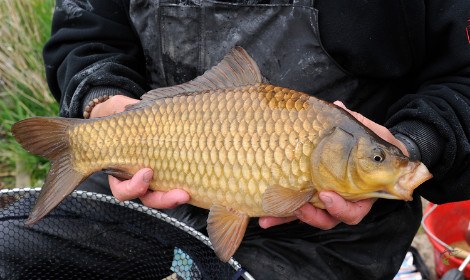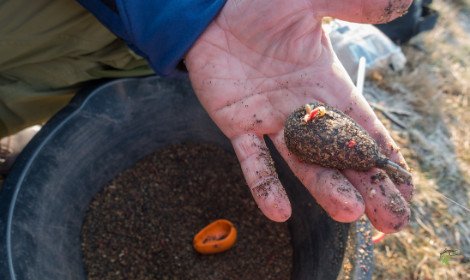
The world of fishing holds a universe within itself. Every fish species has some curious characteristics, some specific techniques make them bite faster and harder, and some physical features that set them apart from other species. Today, we’ll discuss the F1 Carp and everything that sets it apart from other carp species.
The F1 Carp is quickly becoming the most commonly stocked carp in most commercial fisheries. Because of its fast growth, medium build, and strong immunity, this fish is a favourite among most stockists.
If you’re a seasoned angler, the chances are that you know what a hybrid F1 carp is. But do you know all about it? It’s quite an exciting fish to study because not only is it strong and fun to catch, but it also has some features that make it a better catch than common carp. So, what are we waiting for? Let’s dive in.
What Is An F1 Carp?
Also known as the Hybrid F1 Carp, this carp species is a cross between Common Carp and Crucian Carp. Fisheries all over Britain breed this carp for its unique qualities that make it an excellent species to stock in reservoirs, etc.
It is a freshwater fish with characteristics that are a mixture of Common and Crucian Carp. Sometimes, the Common and Crucian Carp also cross under natural conditions and produce the F1 Carp.
F1 Carp is sterile because it is a hybrid offspring of two different carp species. Carp anglers fishing in commercial fisheries catch a lot of F1 Carp because it is easy to stock. It strongly resembles the Common Carp, allowing traditional anglers to feel at home while fishing them.
They are invertebrates and usually feed on insect larvae, aquatic plants, and some small invertebrates like most other carp. Anglers usually catch them for sport only and don’t tend to target them for food.
How To Identify An F1 Carp?
It is very easy to identify an F1 Carp. It has a hunched back appearance like Common Carp and medium weight. They typically weigh 2-4 lbs, with some fish even going up to upwards of 10 lbs.
F1 carp is golden-coloured like the Crucian Carp. However, its body shape is closer in appearance to the Common Carp, but unlike the Common Carp, it does not have the four barbels that the Common Carp is widely recognized by. Instead, it only has two very small barbles that most anglers find challenging to spot.
They never grow to massive sizes like some other carp species such as Koi Carp, Common Carp, and other carp species.
While F1 Carp does not look like Crucian Carp, some anglers still get confused between the two because of the similar colour. If all else fails, an angler can count the number of lateral line scales in an F1 carp, usually 35 or 36. Most anglers know that the lateral line scales in Crucian Carp are usually 32 or 34.
Fishing For F1 Carp
In Terms Of Season
While the F1 carp is known for its ability to feed in the winters and the summers, it is at its most active in the spring and summer. In the summers, they are aggressive feeders and will bite on almost anything.
Many anglers hold competitions in the summers in which the angler with the most F1 carp will win. Carp anglers can even catch up to hundreds of lbs ofF1 Carp in one day in such competitions.
In the winters, anglers get bites when they fish during the daytime and in the warmest hours, such as in the afternoon.
In Terms Of Rigs

In those times, anglers should use light feeder rods for fishing over large distances, such as up to 35-40 feet but with a versatile range of baits. By using light feeder rods, anglers can catch even the most sensitive of F1s.
Why is this? Well, the small feeder and bait that you can attach to light feeder rods attract even the most cautious of fish to bite. In addition, the lines have small diameters which do not unnecessarily scare the carp.
Summers are the best times to catch F1 Carp as they aggressively feed in that time, but they are also good sport in the winters. So it is essential to use light rigs in the winter.
Some anglers use small hooks because they believe that F1 Carp are small-sized fish and will not bite large hooks. However, they usually fail in catching any F1 carp. Why is that?
It is because when they use small hooks, they tend to slip when they retrieve the line.
4mm/6mm pellets paired with a size-18 hook is an excellent rig to catch F1 carp.
In Terms Of Bait
F1 Carp are huge fans of sweetcorn and double maggot bait. Other attractive baits to catch this type of carp are doughballs, bread, and maggots and worms.
Anglers can make their bait look more attractive by using one red maggot and one white maggot when casting the bait.
You can also use compact balls of groundbait for fishing at the bottom. In the colder months, you can also use a method feeder to catch F1 Carp.
Why Do People Breed The F1 Carp?
Many fisheries stock F1 Carp because it is an ideal fish to breed artificially. Why is that? Let’s find out.
There are several reasons why F1 Carp make stocking fish a hassle-free experience, but the most important one is that it feeds in the winters. Most commercial fisheries want anglers to fish in their waters throughout the year.
Another reason is that it is also an excellent choice for carp fishing in the summer months. They feed voraciously and around the clock. Anglers hold fishing tournaments in which the main aim is to catch as many F1 Carp as possible.
They are also immune to the Koi Herpes Virus (KHV), a virus that causes a significant degree of mortality in species related to the Common Carp. A KHV infection usually spelled trouble for owners of commercial fisheries because it meant an 80-100% mortality rate in infected waters.
There have been concerns about using this fish to stock reservoirs and lakes in recent years as it tends to mate with the Crucian Carp. However, it is sterile, so it does not produce any offsprings, leading to a decline in the Crucian Carp population. Some fisheries do not stock them because they find it hard to maintain their population in their waters.
That’s All
Coarse fishing is one of Great Britain’s most common pastimes. Every year, loads of anglers head to tackle stores to stock up on the latest rigs, bait, and other equipment that they’ll need to catch some good fish.
So, to stand out among the scores of carp anglers trying their hand at catching carp across the country, one needs to brush up on all the different types of carp and what they do.
Are you wondering why you need to learn about F1 Carp to improve as a carp angler?
Well, a carp angler is someone who knows all about the different species of carp — not just effective techniques on how to catch them, but also all about their habits, behaviours, and habitats.



Ive just started fishing in the last week at the age of 67 so any advice would be helpful
Hi Christopher,
If you have a look around the site you should find plenty of information that will get you going on your way to catching plenty of fish. I’ll send over our free method feeder guide for you to have a read through as well. Best of luck!
Cheers,
Drew
I am 73, and been Carp fishing for 5 years, I get frustrated when first identical tactics the guy next to me bags up and I blank.!
What am I doing wrong.
Hi James,
Cheers for getting in contact. It could be a handful of things. There’s posts on the site that can point you in the the right direction and give you some things to try. If you are using identical rigs it could be down to your hookbait choice, feeder mix you’re using, if you have baited your swim effectively or not or even just not fishing an effective swim. Have a read at the posts below and I’m sure it should help. If you have anymore issues give me a shout.
https://bestofangling.com/the-best-bait-for-carp/
https://bestofangling.com/pre-baiting-for-carp/
https://bestofangling.com/how-to-find-carp/
We’re also releasing a full guide book in the coming months that could be a great help. If you sign up to our mailing list for the free guide i’ll be sending out update emails when it’s ready for release. Cheers.
I restarted fishing after many years lay off to be amazed by things like Hair rigs, Poles, pre tied rigs etc… many miles away from the split cane rods and wicker baskets.
and have enjoyed learning (or trying to) many new things…
to restart fishing after a long time can be a very bewildering and expensive thing. so admittedly i try to keep to a budget.
i prefer to feeder fish (these old eyes struggle with floats nowadays) and have had some success.
so any tips, hints, advice is always welcome
Hi Gordon,
Great to hear from you.
Ye the sport really has progressed massively in the past decade with plenty of more modern advancements to help us get more fish in the net. I’m a big advocate for feeder fishing and actually have a free 12-page method feeder fishing guide I can send over to you, I’ll do that just now.
There should be plenty of advice, tips and tricks across the site that you can get stuck into reading and if you have any specific questions you can fire them in an email to Drew@Bestofangling.com and I’ll be happy to answer them.
Cheers,
Drew